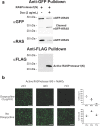Engineering subtilisin proteases that specifically degrade active RAS
- PMID: 33674772
- PMCID: PMC7935941
- DOI: 10.1038/s42003-021-01818-7
Engineering subtilisin proteases that specifically degrade active RAS
Abstract
We describe the design, kinetic properties, and structures of engineered subtilisin proteases that degrade the active form of RAS by cleaving a conserved sequence in switch 2. RAS is a signaling protein that, when mutated, drives a third of human cancers. To generate high specificity for the RAS target sequence, the active site was modified to be dependent on a cofactor (imidazole or nitrite) and protease sub-sites were engineered to create a linkage between substrate and cofactor binding. Selective proteolysis of active RAS arises from a 2-step process wherein sub-site interactions promote productive binding of the cofactor, enabling cleavage. Proteases engineered in this way specifically cleave active RAS in vitro, deplete the level of RAS in a bacterial reporter system, and also degrade RAS in human cell culture. Although these proteases target active RAS, the underlying design principles are fundamental and will be adaptable to many target proteins.
Conflict of interest statement
The authors declare no competing interests.
Figures









Similar articles
-
Engineering substrate preference in subtilisin: structural and kinetic analysis of a specificity mutant.Biochemistry. 2008 Jun 24;47(25):6628-36. doi: 10.1021/bi800089f. Biochemistry. 2008. PMID: 18507395
-
Furilisin: a variant of subtilisin BPN' engineered for cleaving tribasic substrates.Biochemistry. 1996 Oct 22;35(42):13579-85. doi: 10.1021/bi961543h. Biochemistry. 1996. PMID: 8885837
-
Engineering a substrate-specific cold-adapted subtilisin.Protein Eng Des Sel. 2004 Feb;17(2):149-56. doi: 10.1093/protein/gzh019. Epub 2004 Feb 3. Protein Eng Des Sel. 2004. PMID: 15047911
-
KRAS: From undruggable to a druggable Cancer Target.Cancer Treat Rev. 2020 Sep;89:102070. doi: 10.1016/j.ctrv.2020.102070. Epub 2020 Jul 15. Cancer Treat Rev. 2020. PMID: 32711246 Review.
-
Advances in protease engineering for laundry detergents.N Biotechnol. 2015 Dec 25;32(6):629-34. doi: 10.1016/j.nbt.2014.12.010. Epub 2015 Jan 8. N Biotechnol. 2015. PMID: 25579194 Review.
Cited by
-
Recent advances in targeted degradation in the RAS pathway.Future Med Chem. 2025 Mar;17(6):693-708. doi: 10.1080/17568919.2025.2476387. Epub 2025 Mar 10. Future Med Chem. 2025. PMID: 40065567 Review.
-
Biochemical characterization of immobilized recombinant subtilisin and synthesis and functional characterization of recombinant subtilisin capped silver and zinc oxide nanoparticles.Saudi J Biol Sci. 2024 Jul;31(7):104009. doi: 10.1016/j.sjbs.2024.104009. Epub 2024 May 4. Saudi J Biol Sci. 2024. PMID: 38766505 Free PMC article.
-
Intrinsically disordered proteins: Ensembles at the limits of Anfinsen's dogma.Biophys Rev (Melville). 2022 Mar 17;3(1):011306. doi: 10.1063/5.0080512. eCollection 2022 Mar. Biophys Rev (Melville). 2022. PMID: 38505224 Free PMC article. Review.
-
Ionizable lipid nanoparticles for RAS protease delivery to inhibit cancer cell proliferation.J Control Release. 2024 Jun;370:614-625. doi: 10.1016/j.jconrel.2024.05.015. Epub 2024 May 14. J Control Release. 2024. PMID: 38729436 Free PMC article.
-
Design and characterization of a protein fold switching network.Nat Commun. 2023 Jan 26;14(1):431. doi: 10.1038/s41467-023-36065-3. Nat Commun. 2023. PMID: 36702827 Free PMC article.
References
Publication types
MeSH terms
Substances
Grants and funding
LinkOut - more resources
Full Text Sources
Other Literature Sources
Research Materials
Miscellaneous

